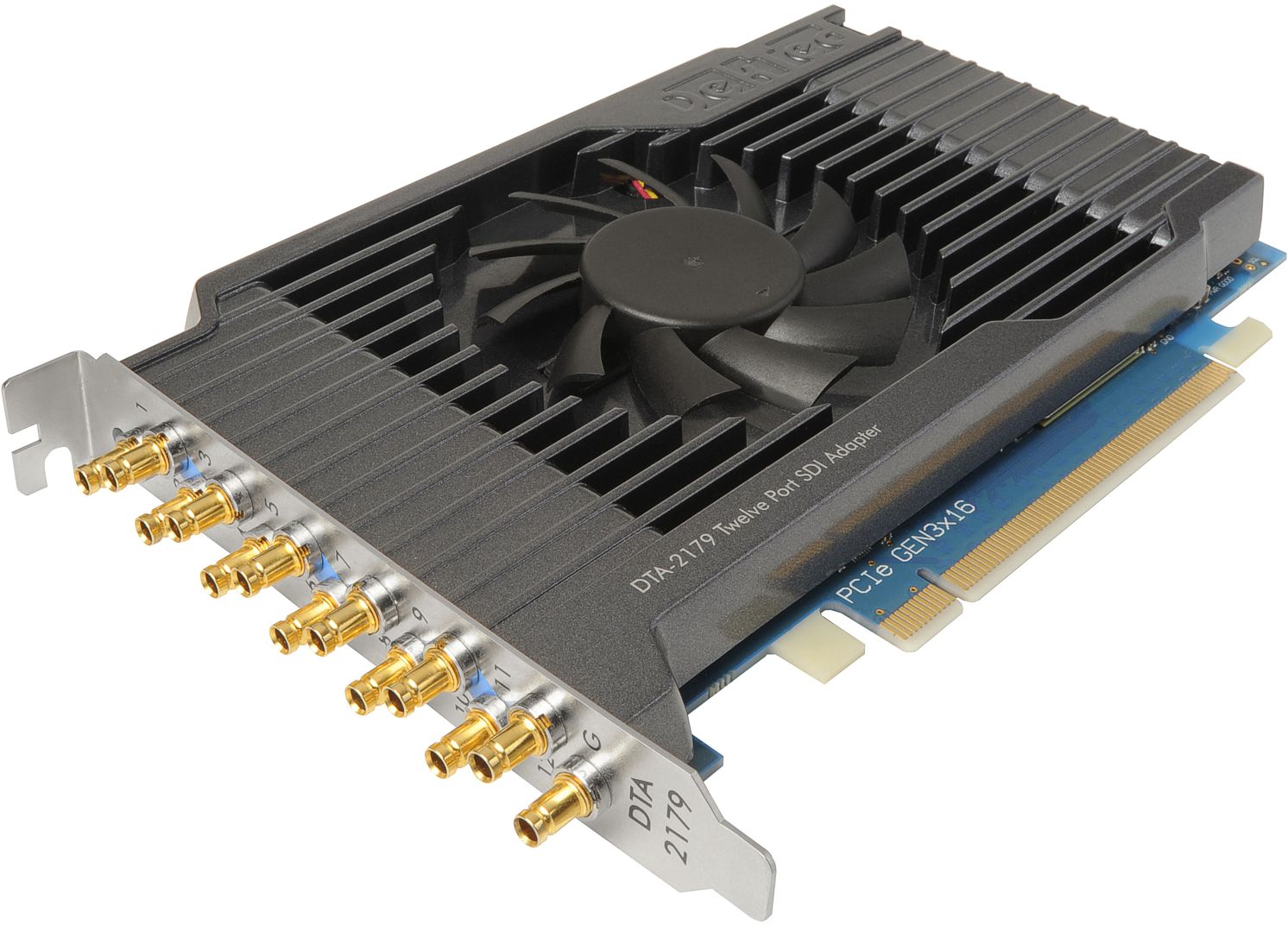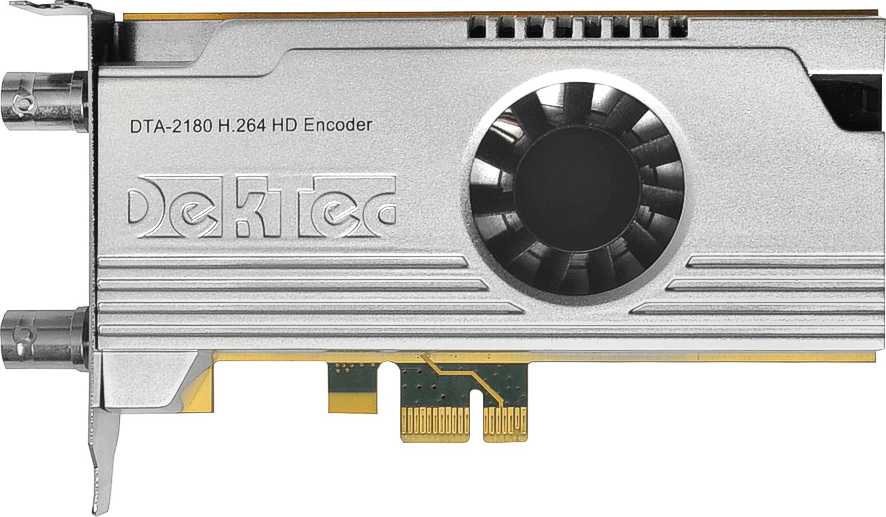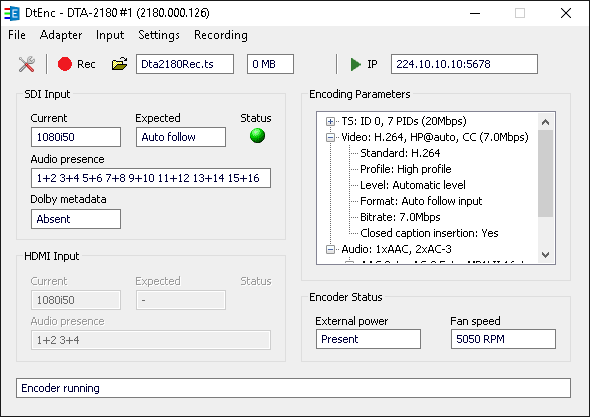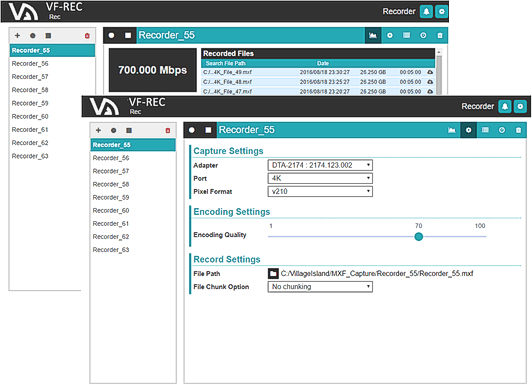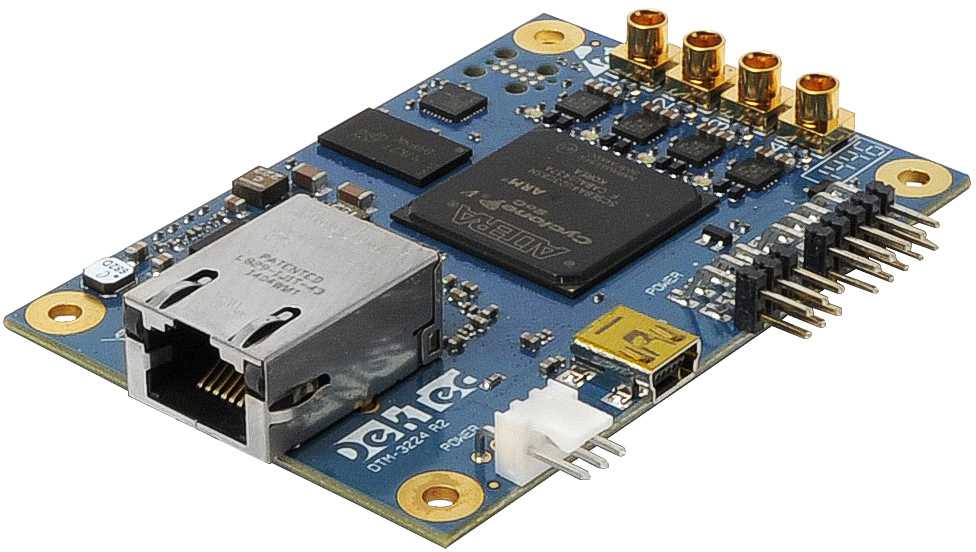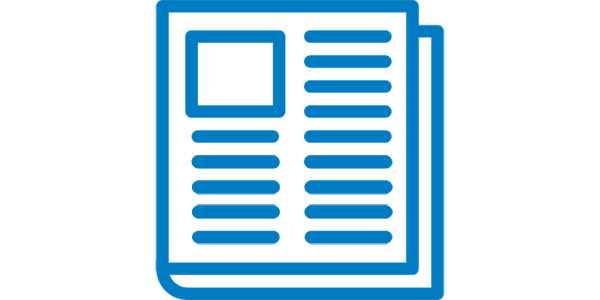
|
News 2016
|
Hilversum, 14 December 2016
DekTec Unveils Complete ATSC 3.0 Toolset
With the standard quickly maturing, DekTec hits the market with a set of high-quality tools for creating and testing ATSC 3.0 solutions. Our portfolio of high-end modulators and receivers now fully supports the latest additions to the standard and enable you - using our easy-to-use DekTec SDK (aka DTAPI) - to build fully compliant ATSC 3.0 playout-, reception- or monitoring equipment. Developers can use DekTec’s playout and analysis applications to validate their own ATSC 3.0 products before releasing them to the market.
ATSC 3.0 in the DekTec SDK
As an active member of the ATSC 3.0 Validation & Verification group, DekTec is at the forefront of implementing the standard and verifying interoperability. This position has enabled us to add virtually all features of the latest ATSC Physical Layer Protocol specification (A/322), including multi-PLP, multiple subframes, Layered Division Multiplexing (LDM) and Hybrid Time Interleaving (HTI) in the DekTec SDK.
The Multi-PLP Extensions, a subsystem of the DekTec SDK for creating multi-PLP modulators, has been extended with support for ATSC 3.0. Your application only needs to pass modulation pararameters and ATSC Link-layer Protocol (ALP) packets. The DekTec SDK takes care of packet scheduling, framing, FEC, interleaving and eventually waveform generation. This way you can build your own transmitter application without having to worry about the lower levels of the transmission.
The Advanced Demodulator API, another subsystem for receiving and analyzing RF modulated signals, has likewise been extended with ATSC 3.0. It uses the DTA-2131 universal VHF/UHF receiver card in combination with Software Defined Radio (SDR) technology. The user application can retrieve real-time information about the RF-signal, bootstrap- and layer-1 parameters. Multiple PLPs can be decoded simultaneously and passed to the user application as ALP packets .
DekTec’s ATSC 3.0 applications
The following applications are included in the DekTec’s ATSC 3.0 toolset:
- Atsc3Xpress is the test-signal generator for ATSC 3.0 transmission, receiver chip development, field trials and demonstrations. Its GUI allows full control over all ATSC 3.0 parameters. It supports playout from a built-in PRBS generator, IP-capture file (PCAP) and live IP-input carrying ROUTE/MMT packets. The DTC-305 option can be added to inject white noise and simulate reflections (multi-path fading).
- Atsc3Xpert is DekTec's ATSC 3.0 receiver and analyzer. Its GUI provides a real-time overview of the RF measurements and ATSC 3.0 signaling parameters. It includes graphical representations of LDPC iterations, transfer functions, impulse response, and constellation. The demodulated stream can be captured to file or forwarded on IP.
About ATSC 3.0
ATSC 3.0 is a suit of standards specifying all layers of a broadcast system including video and audio encoding, transport protocols and physical transmission. Where conventional standards use MPEG-2 Transport Streams, ATSC 3.0 is fully IP based. This enables hybrid broadcast and broadband service delivery e.g. for personalized advertisements.
The physical layer of ATSC 3.0 supports bitrates from less than 1Mbps in the most robust mode up to more than 57Mbps when using the most efficient mode. One emission can carry multiple modes, that allows for the delivery of SD, HD and Ultra HD services to fixed as well as mobile receivers.
ATSC 3.0 uses techniques similar to DVB-T2, including OFDM with a large number of sub-carriers, LDPC error-correction and multiple Physical Layer Pipes (multi-PLP). It also introduces new elements such as the bootstrap signal, new PLP-multiplexing and time interleaving techniques. ATSC 3.0 is incompatible with ATSC 1.0.
Hilversum, 8 November 2016
12x SDI/ASI on a Single PCIe Card: Introducing the DTA-2179
DekTec fulfills the increasing demand for high-density SDI/ASI connectivity with the new DTA-2179. It is the first and currently the only product in the market that has no less than twelve independent SDI/ASI ports and a genlock input. This makes the DTA-2179 perfectly suitable for situations in which server space or cost per port are crucial.
The DTA-2179 is the youngest member of DekTec's family of HD-SDI PCIe boards, which already includes the two-port DTA-2152 and the four-port DTA-2174. All these boards are easily integrated in your custom application by using the free DekTec Matrix API® framework.
Software can configure each port as input or output and as ASI or SDI port. All ports can receive or transmit SD-, HD- and 3G-SDI, as well as DVB-ASI. Twelve simultaneous HD-SDI streams are supported, or eight simultaneous 3G-SDI streams (plus four HD-SDI or ASI), or two 4Kp50/60 quad-link streams.
DTA-2179 - Twelve HD-SDI/ASI ports with genlock
Creating a live production mixer solution is a good example of what can be achieved with the DTA-2179 and the DekTec Matrix API®. Video and audio, received from multiple SDI sources, is made available to a mixer application that can apply any effect in software and create a high-quality television program. The application, and the programmer, need not be aware of the low-level details of SDI. Through the API, an abstraction layer is created that extracts video, audio and data from the SDI streams, and makes it available in a format that is easy to process by software.
Many other applications are conceivable. The large number of ports allows for the creation of multiviewers that monitor many ASI and/or SDI channels, using a single I/O device. The card is also ideal for doing image processing with a multitude of parallel camera inputs. Or, by using eleven ports as ASI inputs and one as ASI output, a very dense multiplexing solution can be created.
We trust your creativity in coming up with other types of applications based on our DTA-2179 and look forward to hearing about them. DekTec has released the product and the DTA-2179 is shipping from stock now.
Hilversum, 5 September 2016
DTA-2180 - Rock-Solid H.264 Encoding with Zero CPU Load
DekTec has released and is shipping the DTA-2180, a general-purpose audio/video encoder card. H.264 and MPEG-2 video encoding for all common HD and SD formats are supported, as well as multi-channel AAC, AC-3 and MP1LII audio encoding. The product uses field-proven Magnum encoding technology for robust 24/7 operation and excellent video quality. Thanks to this hardware-based approach the CPU load is negligible and encoding latency remains low.
DTA-2180 - H.264 HD encoder on a low-profile PCI Express card
The HD-SDI input of the card can be connected to any external SDI source. An alternate HDMI input is available, which is typically connected to the display output of the PC with the DTA-2180 inserted. This enables real-time encoding of the PC's desktop, making it easy to convert the full-screen output of your application to a compressed H.264 stream. You can also encode the output of standard PC applications, e.g. a slide show.
The encoder can be controlled with Windows application DtEnc, which comes with the hardware for free. The GUI allows users to navigate through the available encoding options and parameters, and to oversee the encoder status. DtEnc can output the encoded transport stream over IP on the PC's network port. The encoded stream can also be stored in a file, or it can be processed by another application.
Encoding status overview in DtEnc
You can also create your own Windows- or Linux-based encoder-control application with the freely available DekTec SDK (DTAPI). Please note that DtEnc uses this standard DekTec SDK.
An interesting application of the DTA-2180 is centralized monitoring of a distributed broadcast network. In this scenario servers at remote sites run DekTec’s Xpect Mosaic. The multiviewer output on the HDMI output is looped into a DTA-2180, where it is compressed to a bitrate that can be conveniently transmitted over a WAN to the central monitoring site. Over there the compressed streams from the remote sites are collected and decoded so that a mosaic of all streams can be displayed.
Hilversum, 2 September 2016
Affordable 4K Baseband SDI Recording
It is now possible to perform 4K baseband SDI recording using standard and affordable PC hardware. Village Island and DekTec jointly announce VF-REC v3, a new version of the VF-REC application widely used for recording of transport streams and SDI signals using DekTec’s range of video I/O adapters. With this release, VF-REC receives a major GUI overhaul and introduces the exciting “J2K” option for JPEG 2000 compression.
Recording/playout of an uncompressed 4K video stream in a PC is extremely challenging because of its high bitrate (12Gbps) and requires a special and expensive hard-disk sub-system. Without considerable integration effort it is practically impossible to record or playout 4K signals with a standard PC setup. VF REC v3 overcomes this problem by incorporating JPEG 2000 compression technology from Comprimato. It applies real-time visually lossless compression of 4K video, reducing the data rate sufficiently to use a PC with a standard hard-disk setup. Comprimato’s JPEG 2000 compression technology leverages the GPU resources from graphics boards provided by companies such as NVIDIA and AMD.
VF-REC v3 with new JPEG 2000 compression option
VF-REC stores the JPEG 2000 compressed 4K signal as an MXF-file (OP1a), which means the recorded files can be used by any tool supporting the OP1a MXF-file format. Version 3 also includes functionality for playing back the recorded 4K files.
The recording and playout of UHD requires the usage of a 4K capable DekTec adapter. DekTec’s current flagship 4K product is the DTA-2174 (Quad 3G-SDI/ASI Input/Output adapter), with multiple new 4K products on the roadmap. As they appear, support for these cards will be added to VF-REC.
Please note that support for RF recording has not yet been included in the VF-REC v3 GUI. Therefore, users requiring RF recording shall temporarily keep using VF-REC v2 as maintained on the DekTec website, until VF-REC supports all recording features. The two versions are enabled under the same license.
Contact your (DekTec distributors) or (mailto:Village Island) directly for GPU integration details or advise on purchase.
Hilversum, 11 August 2016
Released and Shipping: DTM-3224 Quad ASI to IP Converter
The DTM-3224 is DekTec’s latest addition to its line of standalone OEM converter modules, currently consisting of DTM-3200 and DTM-3237. Compared to the single ASI port of the DTM-3200, the DTM-3224 has a total of four ASI inputs, allowing for denser implementations of ASI-to-IP conversion devices. On top of that, support has been added for IGMP v3 (source-specific multicast), IPv6 and FEC configurations up to 20x20 for extra low overhead. The DTM-3224 uses the same form factor as the DTM-3200.
The DTM-3224 supports SMPTE 2022-2 for TS-over-IP encapsulation and SMPTE 2022-1 for forward error correction. By using a dedicated hardware architecture, IP source jitter is kept to a minimum. Analogously, as such a hardware implementation requires no buffering, the latency incurred by working with the DTM-3224 is extremely low. The board has specifically been designed for ASI to IP conversion scenarios that require a very low latency.
DTM-3224 - Quad ASI to IP converter
The DTM-3224 is configured and controlled through a dedicated control interface. A choice of three physical serial interfaces is available for configuration and control: USB 2.0, RS-232 or I2C. A Windows GUI tool is part of the package and can be used to configure the ports and output parameters for development and initial configuration. Furthermore, a free C++ API (DtmHandler/DtmCmd), which is consistent across all DekTec DTM products, simplifies Linux or Windows protocol handling and integration in your application.
The DTM-3224 is now available for shipment. For development purposes DekTec offers a development kit (DTM-3224-DEVKIT) consisting of the DTM-3224 module, power supply and USB to serial converter. Please contact DekTec for further information and OEM volume pricing.
Hilversum, 4 July 2016
DekTec Appoints New Director of Sales and Marketing
DekTec is pleased to announce the appointment of Bernie Rietkerken to the position of director of sales and marketing, as part of its expansion program for its growing range of OEM and Test & Measurement products.
In this role, Rietkerken will be responsible for overseeing and maintaining DekTec’s worldwide distributor network, developing OEM sales and contributing to the overall sales and marketing strategy. He will take over from Nilesh Mandalia, DekTec’s current VP of sales, allowing Mandalia to focus more fully on expanding the DekTec UK branch.
“With his proven track record in sales and project delivery at some of the main players in the industry, along with a deep understanding of broadcast technology, Bernie is an ideal addition to our management team. We look forward to leverage his expertise and international mindset, as DekTec continues to grow in areas like enabling PCs for video-over-IP solutions.”
Sito Dekker, CEO of DekTec
“Having seen DekTec grow to an established worldwide supplier to the digital video industry, I am really excited to have joined DekTec and help them improve customer satisfaction and expand to new levels of market presence and sales volume.”
Bernie Rietkerken, Director of Sales and Marketing
About Bernie Rietkerken
|
|
Bernie can build on 20 years of experience in the Digital Video domain. He started his career at Philips Digital Video Systems as a system architect, followed by various roles in product management and sales in Philips, Teleste, and Irdeto. For the latter he set up the Middle-East regional office in Dubai and managed the region for 4 years. Bernie spent the past 3 years at SeaChange International, where he was responsible for sales and account management in Benelux, the Nordic region, the Baltics, and Ireland. |
From this background, which lately has become increasingly sales-oriented, but still with a strong affinity for technology, Bernie aims to lead DekTec’s sales and marketing efforts going forward, in close cooperation with existing distributors as well as the local DekTec teams in the USA and UK.
Bernie lives in Hilversum, the Netherlands, with his wife, son and two daughters.
Hilversum, 14 Apr 2016
DTA-2115B is Available and Shipping
DekTec has released and is shipping the DTA-2115B, its highest-end test modulator for satellite, terrestrial and cable modulation standards. The latest standards, including DVB-T2, DVB-S2(X) and ATSC 3.0, are fully supported.
DTA-2115B - All-band all-standard modulator for PCIe
The card houses a high-quality oscillator with exceptionally low phase noise. Modulation and upconversion is done all-digital, resulting in excellent signal quality over VHF, UHF and L band.
The DTA-2115B has a number of special features:
- 1-pps and 10-MHz inputs for GPS clock synchronization. This enables operation of the DTA-2115B in a Single Frequency Network (SFN); It also allows synchronizing multiple modulator cards to each other accurately, e.g. for experiments with SFN or MIMO.
- Phase noise emulation. The phase of the local oscillator that generates the carrier frequency can be modulated with a digital signal supplied over the PCIe bus. This enables the injection of user-defined phase noise, for example to validate or experiment with the locking behaviour of receivers.
These two features are included in the base product without requiring an additional license.
8-Channel Firmware Option
An exciting new firmware variant transforms the DTA-2115B into eight independent modulators. This option allows you to modulate up to eight channels with a maximum bandwidth of 8MHz each. The channels can be located anywhere in the VHF or UHF band, in any combination of terrestrial and cable modulation standards, e.g. 4x DVB-T2 and 4x DVB-C.
Example of a spectrum created with the 8x 8-MHz firmware variant of the DTA-2115B
The 8-channel firmware makes the DTA-2115B a compact and cost-effective solution for applications that require a large number of modulated channels:
- Generating a network of channels in the lab, e.g. for testing and validating receivers when a full spectrum with tens of channels is used.
- Creating an actual cable or terrestrial broadcast system with many channels, e.g. in a hospital, campus, shop or hotel.
The channels can be generated by running StreamXpress: On one DTA-2115B, eight instances of StreamXpress can be run. You can use StreamXpress remote control (SpRcApi) for automating such a configuration. For even more flexibility, DekTec's real-time multiplexer MuxXpert can be used.
The order code for the eight-channel firmware is DTC-385-HW8CH. The DTA-2115B-GOLD includes the multi-channel option, too. If the card is licensed for the 8-channel option, you can use DtInfo to switch between the 1x 72-MHz and 8x 8-MHz firmware.
